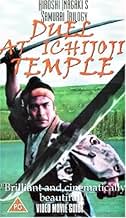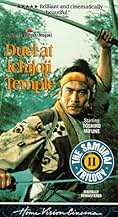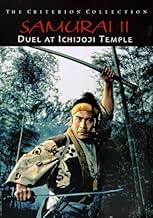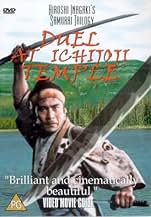VALUTAZIONE IMDb
7,3/10
7323
LA TUA VALUTAZIONE
Aggiungi una trama nella tua linguaMusashi Miyamoto returns to Kyoto after years of absence. After a series of fights against the Yoshioka School, he challenges its master to a duel.Musashi Miyamoto returns to Kyoto after years of absence. After a series of fights against the Yoshioka School, he challenges its master to a duel.Musashi Miyamoto returns to Kyoto after years of absence. After a series of fights against the Yoshioka School, he challenges its master to a duel.
- Regia
- Sceneggiatura
- Star
Recensioni in evidenza
This comment about the "Samurai Trilogy" starts on the page for Miyamoto Musashi (Samurai I). My first viewing of the second episode was memorable because I got to take the train into town all by myself, and view it in a Tokyo theater. The first episode had just been shown on base, in a sort of cultural exchange, and my parents saw it and were pleasantly non-outraged-- I was a 9-year-old samurai-movie addict, and they believed enthusiasm beyond a certain intensity should be curbed. It was the same conflict as comic books some few years earlier. Technicolor was a big deal back then, especially in Japan, and it became the issue on which my viewing of "swordfighting movies" was decided-- the ones in color were historical films worth viewing, and even had something to teach. The black-and-white ones shown in Irumagawa and surrounding villages-- I had to sneak off to see. Ichijoji no Ketto (Duel at Ichijoji Temple) shows Miyamoto-san's achievements, while barring no holds on the issue of what they cost him. The romantic subplot continues, though its development in the western sense (toward union, wedded bliss) is thwarted at every turn. The issue is always a conflict between love and duty, and each deferment of gratification spells out a new step in the redefinition of the national character that is being mapped here. Again, some of the importance of all this is lost, even to modern Japanese audiences for whom the issues are long settled-- at the time, though, they were cliffhangers. A new character is introduced, Kojiro Sasaki who will emerge in part 3 as a rival for Musashi-- his equal except for certain features in their respective character. By the way, the score is excellent and haunting-- it extends like a symphony through all three parts, and has a leitmotif "hook" that will cause your ears to pick up in recognition, perhaps years from now, when you hear it again.
The follow-up to 1954's excellent Musashi Miyamoto, Duel at Ichijoji Temple picks up the story several years later, as an exiled orphan-turned-swordsman gains notoriety via a bloody tour of fatal duels. His reputation precedes him in returning to his hometown, where old rivals of both a violent and intimate nature await. This is a film about personal growth - specifically that of the samurai himself, who struggles to learn the key concepts of what his new life actually entails and where the rift lies between honor and reverence. We're never quite sure if Musashi takes this lesson to heart, particularly since he's so keen to maintain an impenetrable outer facade in almost every situation. It's a tricky role for period veteran Toshiro Mifune, who struggles with the more nuanced, flatter aspects of the character. In the previous episode, with the fires of young-adulthood to toy with, he excelled. Here, faced with the malaise of mid-life and the accompanying questions of his own being, his performance is far less sublime. The plot, cramped with too many faces and several seemingly-pointless subplots, does him no favors in dancing around the issues and repeating itself on more than one occasion. This could have been an excellent one-act show, and the final half-hour could still stand alone as precisely that. It lacks the gumption of its predecessor, however, and too often cuts away just as the action is getting good.
The tale of Myamoto Musashi - thief, lover, rogue, then warrior, hero and master - is enshrined in Japanese culture, perfect showcase material as it were. It has been adapted more than once to the screen, and Inagaki's classy, colorful version is perhaps the best known. It is everything you'd expect from a period samurai film if you've never seen one and harbor no negative preconceptions.
After a playful first part that has a classic hero's journey structure, part II takes things to the next level without having to rush to the finish, and is the more interesting film. It allows the hero to wield his newfound power without the restraint and inner peace he will later find. It allows him the get mad, and nobody does unleashed fury like Toshiro Mifune, not when you throw 80+ armed fools in this way.
I chose to review this one because it is a good sample of the very best this trilogy accomplishes: compelling archetypical characters, lush cinematography and that "oriental" elegance that always seduces non-Japanese audiences, drawn in as they are by the very universal plot and character dynamics.
I cannot put it in the same leagues as the masterpieces of Kurosawa, Ozu and Kobayashi, but if it is to be a gateway film experience, then it is a bloody good one, and laudable for what it accomplishes.
You might really enjoy this, and if you do, it's just the beginning!
After a playful first part that has a classic hero's journey structure, part II takes things to the next level without having to rush to the finish, and is the more interesting film. It allows the hero to wield his newfound power without the restraint and inner peace he will later find. It allows him the get mad, and nobody does unleashed fury like Toshiro Mifune, not when you throw 80+ armed fools in this way.
I chose to review this one because it is a good sample of the very best this trilogy accomplishes: compelling archetypical characters, lush cinematography and that "oriental" elegance that always seduces non-Japanese audiences, drawn in as they are by the very universal plot and character dynamics.
I cannot put it in the same leagues as the masterpieces of Kurosawa, Ozu and Kobayashi, but if it is to be a gateway film experience, then it is a bloody good one, and laudable for what it accomplishes.
You might really enjoy this, and if you do, it's just the beginning!
I've watched the entire trilogy of the Musashi Miyamoto films, of which this film is the second part. The first film, titled simply "Musashi Miyamoto," introduces us to the characters of this and the third film. Without having seen the first film and developing some interest in the welfare of the characters, I certainly wouldn't have sat through the second and third films.
"Duel at Ichijoji Temple," this film, deals with Musashi's exploits as a sort of samurai knight-errant, seeking glory in a very ambiguous and roundabout way. Two women are trailing after him, as Kurosawa films would say, "like goldfish dung." Musashi himself is a flat character on whom Toshiro Mifune's acting skills are wasted. He displays very little emotion or intellect, despite his supposed interest in one of the women and enlightening education by his monk teacher (as we saw in the first film).
If Musashi is flat, the female characters are steamrolled. Their hand wringing, collapsing, and sobbing is typical of American movies of this time period and grows tedious in a samurai film. Having seen other films from this time period set in the days of samurai, I've seen that much more can be done with female characters. The plot was likewise predictable and slow-moving.
If you don't care about characters or plot, the high points of the movie may compensate: beautiful color landscapes and Toshiro Mifune's thrilling fight scenes. Otherwise, I recommend films by Kurosawa or Mizoguchi ("Sanjuro," the mysterious "Ugetsu") over this trilogy. 5/10
"Duel at Ichijoji Temple," this film, deals with Musashi's exploits as a sort of samurai knight-errant, seeking glory in a very ambiguous and roundabout way. Two women are trailing after him, as Kurosawa films would say, "like goldfish dung." Musashi himself is a flat character on whom Toshiro Mifune's acting skills are wasted. He displays very little emotion or intellect, despite his supposed interest in one of the women and enlightening education by his monk teacher (as we saw in the first film).
If Musashi is flat, the female characters are steamrolled. Their hand wringing, collapsing, and sobbing is typical of American movies of this time period and grows tedious in a samurai film. Having seen other films from this time period set in the days of samurai, I've seen that much more can be done with female characters. The plot was likewise predictable and slow-moving.
If you don't care about characters or plot, the high points of the movie may compensate: beautiful color landscapes and Toshiro Mifune's thrilling fight scenes. Otherwise, I recommend films by Kurosawa or Mizoguchi ("Sanjuro," the mysterious "Ugetsu") over this trilogy. 5/10
Samurai II: Duel at Ichijoji Temple is the second part of the so-called Samurai trilogy by Inagaki Hiroshi about legendary historical figure Miyamoto Musashi who was a highly accomplished samurai who wasn't only a great fighter but also an intellectual philosopher and a skilled artist. This movie shows how a young ronin travels the country for enlightenment and training for several years to become an accomplished samurai.
The main plot of the movie focuses on Miyamoto Musashi challenging a martial arts school. He also meets respectable opponent Sasaki Kojiro who he will eventually fight in the last film. His relationship with Otsu is further explored as she patiently waits for his destiny to be fulfilled.
In comparison to the first movie, this sequel has more fight scenes that are quite dynamic, epic and tense. The movie starts with an impressive duel and ends with a fight between Miyamoto Musashi on one side and eighty martial arts school students on the other side. The film has an overall quicker pace than the first part and is thoroughly entertaining.
All beloved characters from the first movie are back in the sequel and Mifune Toshiro's acting skills are once again quite impressive even though he seems to be acting too impulsively at times to portray a character who has undergone changes to find peace of mind. Mifune Toshiro fits the role much better in the energetic first film and accomplished third movie of the trilogy.
The main reason why this movie is the weakest part of the trilogy is because it skips three years in the life of Miyamoto Musashi and fails to tell how the protagonist has changed. This is even more inappropriate regarding the side characters. The last time we saw the protagonist's childhood friend Matahachi, he was engaged to Otsu but had parted with beautiful Akemi and her manipulative mother Oko to protect them against bandits. Three years later, he has suddenly married Oko who is though having a romantic relationship with Toji who works for a wealthy martial arts school owner whom he expects to marry Akemi and hopes to make lots of money in the process. It's never explained how Oko and Matahachi got married, how their relationship failed and how Toji met the unstable trio.
Despite a few plot holes and some lack of character development, it's essential to watch Samurai II: Duel at Ichijoji Temple as a link between the energetic first film and the accomplished third movie. This second part is still entertaining with its wonderful cinematography, improved fight scenes and plot filled with sinister intrigues. Don't jump on the tiring Game of Thrones bandwagon and watch this movie instead which offers similar contents with more style.
The main plot of the movie focuses on Miyamoto Musashi challenging a martial arts school. He also meets respectable opponent Sasaki Kojiro who he will eventually fight in the last film. His relationship with Otsu is further explored as she patiently waits for his destiny to be fulfilled.
In comparison to the first movie, this sequel has more fight scenes that are quite dynamic, epic and tense. The movie starts with an impressive duel and ends with a fight between Miyamoto Musashi on one side and eighty martial arts school students on the other side. The film has an overall quicker pace than the first part and is thoroughly entertaining.
All beloved characters from the first movie are back in the sequel and Mifune Toshiro's acting skills are once again quite impressive even though he seems to be acting too impulsively at times to portray a character who has undergone changes to find peace of mind. Mifune Toshiro fits the role much better in the energetic first film and accomplished third movie of the trilogy.
The main reason why this movie is the weakest part of the trilogy is because it skips three years in the life of Miyamoto Musashi and fails to tell how the protagonist has changed. This is even more inappropriate regarding the side characters. The last time we saw the protagonist's childhood friend Matahachi, he was engaged to Otsu but had parted with beautiful Akemi and her manipulative mother Oko to protect them against bandits. Three years later, he has suddenly married Oko who is though having a romantic relationship with Toji who works for a wealthy martial arts school owner whom he expects to marry Akemi and hopes to make lots of money in the process. It's never explained how Oko and Matahachi got married, how their relationship failed and how Toji met the unstable trio.
Despite a few plot holes and some lack of character development, it's essential to watch Samurai II: Duel at Ichijoji Temple as a link between the energetic first film and the accomplished third movie. This second part is still entertaining with its wonderful cinematography, improved fight scenes and plot filled with sinister intrigues. Don't jump on the tiring Game of Thrones bandwagon and watch this movie instead which offers similar contents with more style.
Lo sapevi?
- QuizMusashi Miyamoto (Toshiro Mifune) is seen carrying two swords. This was a samurai custom known as daisho. Translated this means 'big-little'. The bigger of the two blades was the curved katana, which was generally used for combat and duelling. The short sword was the wakizashi, this blade was generally associated with committing seppuku, however, as can be seen in the film was also used for combat.
- BlooperMany of the guys killed in swordplay go down with either no visible contact between their bodies and a katana, or appear to be hit in the arm or leg with a non-fatal slash that stills ends them, regardless.
- Citazioni
Musashi Miyamoto (Takezo): I renounce my love of women.
- ConnessioniFeatured in Miyamoto Musashi kanketsu-hen: Kettô Ganryû-jima (1956)
I più visti
Accedi per valutare e creare un elenco di titoli salvati per ottenere consigli personalizzati
- How long is Samurai II: Duel at Ichijoji Temple?Powered by Alexa
Dettagli
- Data di uscita
- Paese di origine
- Lingua
- Celebre anche come
- Samurai II: Duel at Ichijoji Temple
- Luoghi delle riprese
- Azienda produttrice
- Vedi altri crediti dell’azienda su IMDbPro
- Tempo di esecuzione
- 1h 44min(104 min)
- Mix di suoni
- Proporzioni
- 1.37 : 1
Contribuisci a questa pagina
Suggerisci una modifica o aggiungi i contenuti mancanti
































